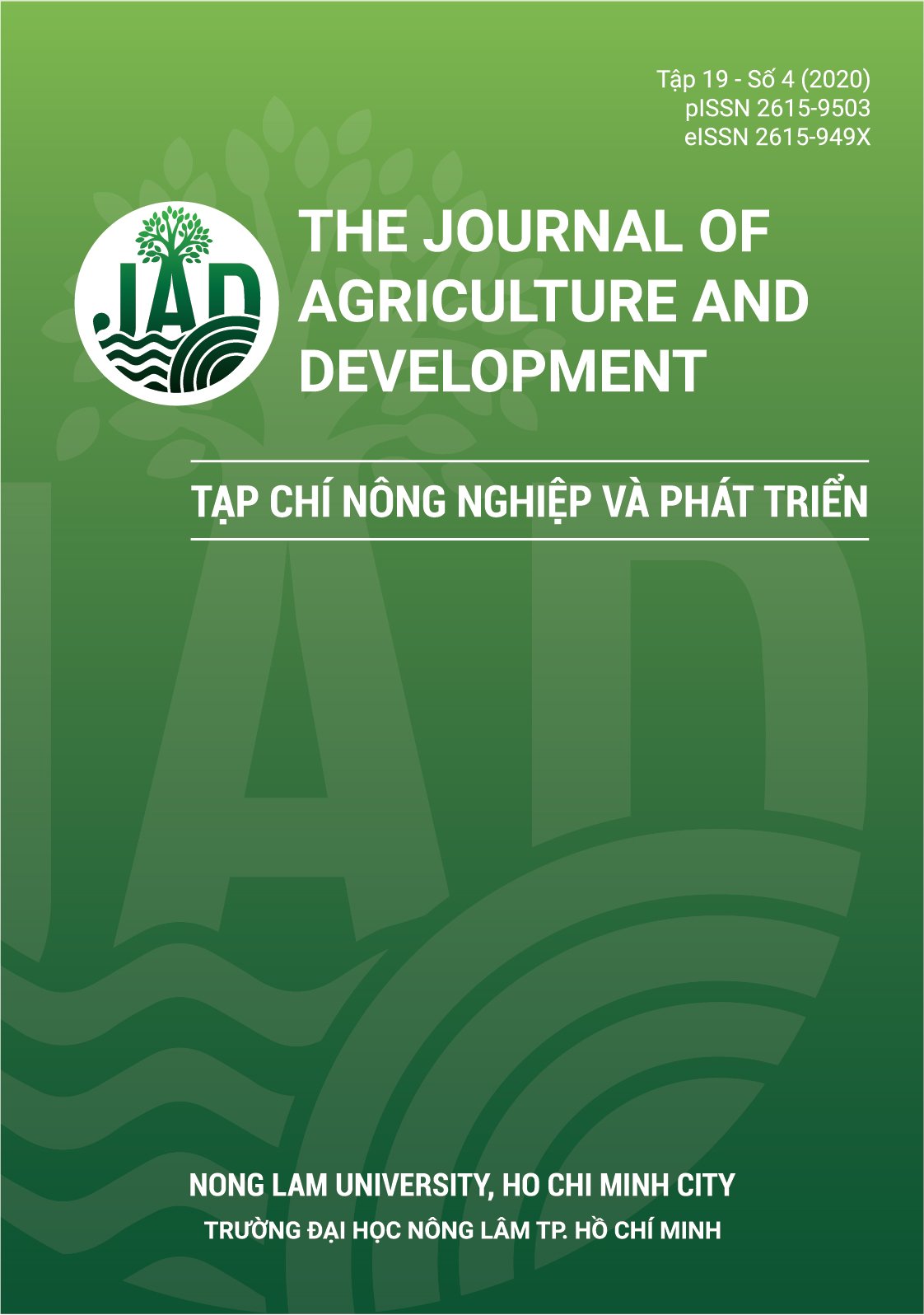Effects of phosphorus fertilizer on growth, yield and quality of coconut at early reproductive stage under saline intrusion condition in Mekong Delta
Main Article Content
Abstract
Coconut palm (Cocos nucifera L.) is one of the most important oil crops in the tropics. The tree is able to grow well under saline intrusion con-dition. However, in the case of high level of salinity for a long period, the coconut tree is severely affected, resulting in poor growth and yield. Therefore, providing balance and sufficient nutrients would help plants tolerate better to unsuitable environment including salinity. Among plant macronutrients, phosphorus is considered to help coconut tree have more roots and leaves, stimulating flowers formation and fruit setting which lead to improve yields. The aim of this work was to determine effects of the amount of phosphorus fertilizer and the frequency of application on growth, yield and quality of coconut tree at early reproductive stage under saline intrusion condition. Two two-factor experiments were con-ducted in Binh Dai district, Ben Tre province and Tan Phu Dong district, Tien Giang province where the highest salinity in the dry season reached 13.8%₀ and 6.3%₀, respectively. The treatments of experiments were ar-ranged in split-plot design (SPD) with three replications. The main plot factor was the frequency of phosphorus fertilizer application (2 and 4 times per year) and the sub-plot factor was the amount of phosphorus fertilizer (30, 45, 60 and 75 kg P2O5/ha/year). The results showed that coconut trees grew best with the treatment of four applications of 60 kg P2O5/ha/year, corresponding to 0.3 kg P2O5/tree/year. The trees in this treatment had more leaves, fruit setting, nut number per tree and higher yield than other treatments under saline intrusion condition.
Article Details
References
BTSO (Ben Tre Statistic Office). (2018). Report for social and economic situation in the first ten months in 2018 in Ben Tre province. Report No. 588BC-CTK dated October 25, 2018. Ben Tre, Vietnam: BTSO.
Cheng-Xu, S., Hong xing, C., Hong bo, S., Xin tao, L., & Yong, X. (2011). Growth and physiological response to water and nutrient stress in oil palm. African Journal of Biotechnology 10(51), 10465-10471. https://doi.org/10.5897/AJB11.463
FAO (The Food and Agriculture Organization). (2020). Area harvested and production quan- tity of coconut. Retrieved August 1, 2020, from http://www.fao.org/faostat/en/#data/QC.
IRHO (Research Institute for Oil and Oil Plants). (1992). Coconut - Study of yield factors. Paris, France: IRHO.
Loganathan, P., & Balakrishnamurti, T. S. (1980). Effects of NPK fertilizers on young coconut (Cocos nucifera L.) in Sri Lanka. Experimental Agriculture 16(1), 41-48. https://doi.org/10.1017/S0014479700010681
Nampoothiri, K. U. K., Krishnakumar, V., Thampan, P. K., & Nair, M. A. (2018). The coconut palm (Cocos nucifera L.) - Research and development perspectives. Singapore: Springer. https://doi.org/10.1007/978-981-13-2754-4
Nguyen, V. B., Tran, H. V., & Le, P. T. (2005). Perennial crops, part II industrial crops. Can Tho, Vietnam: Can Tho University Publishing House.
Pham, L. T., Vo, L. V., Nguyen, H. T. B., Luu, T. Q., &Pham, T. P. (2010). The perfect research on scientific data of four indigenous coconut varieties to apply for seed recognition. Ho Chi Minh City, Vietnam: Research Institute for Oil and Oil Plants.
Remison, S. U., Iremiren, G. O., & Thomas, G. O. (1988). Effect of salinity on nutrient content of the leaves of coconut seedlings. Plant and Soil 109(1), 135-138. https://doi.org/10.1007/BF02197593
Santos, G. A., Batugal, P. A., Othman, A., Baudouin, L., & Labouisse, J. P. (1996). Manual on standardized research techniques in coconut breeding. Singapore: International Coconut Genetic Resources Network.
Thai, T. N. Q., Luu, T. Q., Pham, T. P., Nguyen, P. T.M., Nguyen, H. T. B., Nguyen, T. D. H., & Ngo, D.T. K. (2018). The adaptive studies of coconut to saline intrusion conditions (2016 - 2018). Ho Chi Minh City, Vietnam: Research Institute for Oil and Oil Plants.
Thai, T. N. Q., Luu, T. Q., Pham, T. P., Nguyen, P. T.M., Nguyen, T. D. H., & Nguyen, H. T. B. (2020). Effects of fertilizer on growth, development and yield of coconut under saline intrusion conditions in the Mekong Delta. Vietnam Trade and Industry Review, 38-40.
Thai, T. N. Q., Ngo, D. T. K., Nguyen, H. T. B., Luu,T. Q., Pham, T. P., & Nguyen, P. T. M. (2015). The adaptive studies of coconut to saline intrusion conditions (2013 - 2015). Ho Chi Minh City, Vietnam: Research Institute for Oil and Oil Plants.
Ton, T. T. (1974). Improving the coconut industry in Vietnam. Ha Noi, Vietnam: The Agricultural Publishing House.
Tran, H. V., & Nguyen, L. C. (2011). Investigating flower- ing characteristics of some tall coconut cultivars (Cocos nucifera L.) in Giong Trom district, Ben Tre provine. Can Tho University Journal of Science 17(a), 210-218.
Tran, H. V., & Trieu, Q. D. (2011). Survey of factors in ralation to yield, ‘fruitless phenomenon’ and cultivation method testing on ‘Ta Xanh’ coconut in Ben Tre province. Can Tho University Journal of Science 17(b), 272-281.








